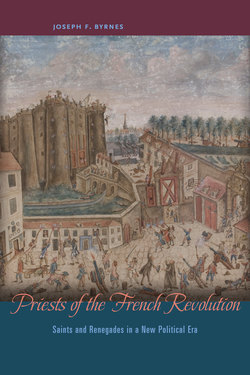Читать книгу Priests of the French Revolution - Joseph F. Byrnes - Страница 15
На сайте Литреса книга снята с продажи.
ОглавлениеChapter Four
THE CHURCH OF ADRIEN LAMOURETTE AND HIS ALLIES
At the center of both religious and political action in the first years of the Revolution, Adrien-Antoine Lamourette was an inspiration and guide for the high-energy church–state activities of both Henri Grégoire and Claude Fauchet. He was also a bridge personality between the towering figure of the National Assembly, the comte de Mirabeau, and the church law scholar, Armand-Gaston Camus, advising Mirabeau on matters ecclesiastical and promoting the reforms of Camus. Appropriately elected and consecrated a constitutional bishop, Lamourette was subsequently elected to the Legislative Assembly, the setting for his dramatic call for political reconciliation, the “Kiss of Lamourette.” The complexity of his personality and theological program has now received full treatment in the work of Caroline Chopelin-Blanc.1
The comte de Mirabeau, Honoré-Gabriel Riquetti, was not only the dominant aristocratic personage in the Constituent Assembly; he was the most authoritative personage there from any level of society. Had he lived, Mirabeau might have been the uncontested leader of the Revolution, which he would have channeled into a constitutional monarchy—the debate is still on, however, as to how far he was willing to go to save the monarchy. We can at least say that Lamourette’s confidence in Mirabeau’s apparent good faith promotion of the Constitutional Church was not fully justified, for Mirabeau was playing churchmen against one another, trying to gain time as he worked with King Louis to strengthen the monarchy.2 He appeared to be a patron of the Constitutional Church, and he tried to advise the king himself in all areas of government at the same time, including religion. As soon as Mirabeau drafted Lamourette as his counselor on church–state affairs, the latter helped him with a speech, presented on 2 November 1789, against the privileges of the clergy and in favor of the seizure of ecclesiastical properties.3 Later Lamourette abetted and advised Mirabeau for his speech in the Assembly on behalf of the establishment of the Constitutional Church. In turn, Mirabeau strongly supported Lamourette for the see of Lyon, traditionally the archdiocese of the primate of France—in dignity, though not authority and power, more important than the see of Paris: “Mirabeau was no stranger to the Lyon election. It was he who designated the candidate, saying that no one else was capable of filling the position. The zeal that he employed in this situation was a payment for services rendered.”4 And on 27 March 1791 Lamourette was consecrated bishop by Gobel in Notre-Dame Cathedral. Lamourette was an ardent proponent of theories on church authority worked out by the theologian and canon lawyer Gaston Camus, “who brings together a strict Christianity, a clear and precise mind, and the talent for discerning customs born of superstition and ignorance from those which follow the inviolable principles of the divine constitution of the church.”5 Camus’s contribution to the structuring of the Civil Constitution was, if anything, more important than Lamourette’s own writings and advice, and more vociferous than the speech style of Mirabeau!6 Across those 1790 discussions of the Civil Constitution of the Clergy, the voice of Camus, canon lawyer and dedicated lay Catholic, was instrumental in moving the debate forward in the Constituent Assembly.
The Reality of the Catholic Constitutional Church
Focusing on the challenges of the church’s contemporary role in society, Lamourette developed a formal, balanced theology of the church from the top down: the role of the pope, as well as the prerogatives of the bishops as the successors of the apostles (no more beholden to the pope for their spiritual powers than the apostles were beholden to Peter). On a presumed scriptural basis and in the light of history and legal reasoning, the role and prerogatives of the French church become clear, and Lamourette was sure that they coordinated perfectly with the new revolutionary government. Given this theology, his talents, and his connections, Lamourette would have been a likely candidate for the office of constitutional bishop, even without the attention and backing of Mirabeau. A crabbed and crabby description of Lamourette’s formal taking of office was published in the Revue du Lyonnais: “The bishop, surrounded by unbelieving magistrates and having on either side of him a Calvinist minister and a scandalous priest, preceded by the national guard, had less the air of a pastor entering his sheepfold, than the winner of an episcopal residence, who, braving all the decorum, begins by solemnizing the equality of all religions.”7
A long pastoral instruction, really a small book, appeared at the beginning of Lamourette’s short tenure as the constitutional bishop of Lyon.8 It was a balanced and complete summary of the polity and theology of the Constitutional Church.9
